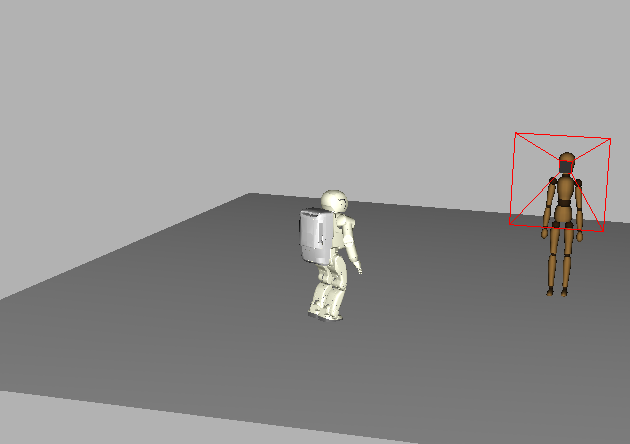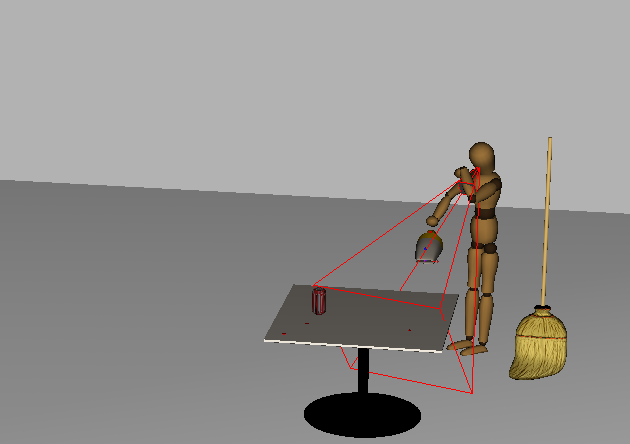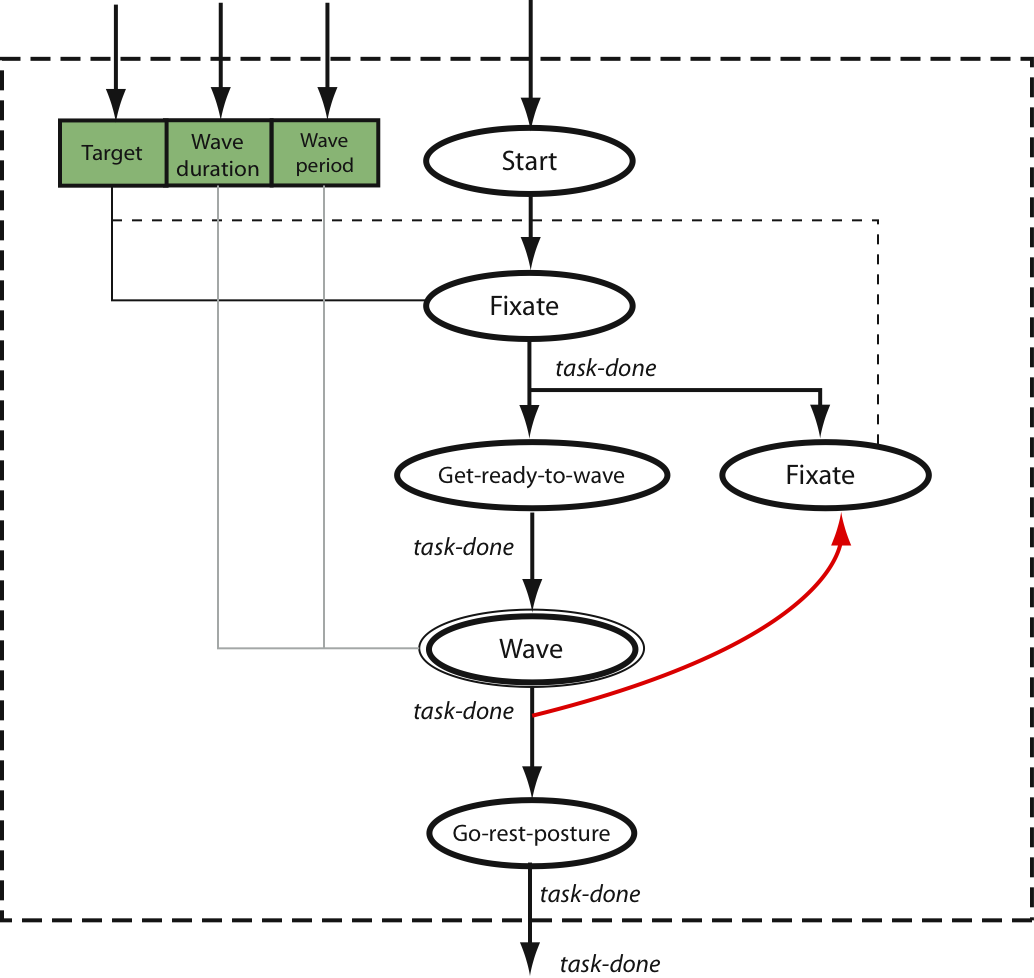Task Matrix
My dissertation investigated means to program behaviors on humanoid
robots. Programming humanoid robots to execute arbitrary tasks
is difficult for numerous reasons, including high
kinematic redundancy, complex dynamics, and the problems involved
with balancing and locomotion. Additionally, once behaviors have
been developed, "porting" a program to a robot with even
slightly different kinematics or dynamics is generally quite
difficult.
Consequently, behaviors
are typically written anew, thus ignoring one of the key tenets of
software development, component reuse.
The Task Matrix (from the definition for matrix as a
surrounding medium or structure) framework promotes portability of
humanoid behaviors by providing a consistent interface to
access robot hardware; in collaboration with
Honda Research Institute, USA, I have developed robot-independent
behaviors such as pointing, reaching, and fixating.
My dissertation examined how the Task Matrix can be used to perform
occupational tasks (i.e., tasks performed in the workplace). I
implemented a large subset of the MTM-1 work measurement system's
task primitives; MTM-1 is a proven system for decomposing
occupational tasks into primitives. Thus, a full implementation of
MTM-1 provides some measure of completeness over the space of
occupational tasks. The combination of the robot-independence
provided by the Task Matrix framework and the approximate completeness
offered by the MTM-1 inspired behaviors results in a constantly
improving set of behaviors for performing useful tasks.
Videos from research into the Task Matrix
Waving
The following two movies show Asimo and the mannequin waving using a
"canned" (i.e., free-space movement) task program.
NEW! Physically embodied Asimo waving:
Fixating
Videos showing both robots focusing their gaze on moving objects.
fixate obviously works on unmoving targets as well. Note that
the fixate program attempts to use the degrees-of-freedom of both
the base orientation and the neck; if not possible (e.g., the base DOF
are currently being used for reaching), only the DOF for the neck are used.

Asimo focusing its gaze on a rolling tennis ball.
|

The mannequin focusing its gaze on a rolling tennis ball.
|

Asimo fixating on another, walking Asimo.
|

The mannequin fixating on a walking Asimo.
|
NEW! Physically embodied Asimo fixating on a wine flute (augmented with
a marker to aid in object recognition). The goal of the
task is to keep the cup centered in Asimo's camera display. The movie on
the right shows Asimo's viewpoint:
Pointing
Pointing is a sophisticated behavior that conveys intention, trains the
sensors, and is useful for communication. The video on the left shows
the simulated robot pointing (one arm points while the other trains an
arm-mounted camera on the target), and the video on the right shows the
physically embodied robot pointing; the object to be pointed to is a
wine flute (augmented with a marker to facilitate recognition).
Reaching
Reaching is used to prepare the robot to grasp an object. Multiple
valid pregrasping configurations for the hand may be specified to
address the scenario when one or more configurations is unreachable.
"Interactive" reaches are shown below. Each time the robot reaches to
the tennis ball, it is moved to a new location. This video shows
that motion-planning is used (in real-time) to navigate
around obstacles.
NEW! Physically simulated Asimo reaching (to 15cm) away to a wine flute.
We are currently getting this behavior working on the robot.
Grasping
Videos showing Asimo grasping a couple of objects. No videos of the
mannequin are shown grasping.
Releasing
A video showing Asimo releasing a grasped object. No videos of the
mannequin are shown grasping.
Exploring the environment
The Task Matrix utilizes a passive sensing model to allow task programs
to query the environment. The model of the environment is typically kept
updated by fixating on manipulated objects, but the model must be
constructed to map object locations for manipulation and collision
avoidance. The explore task program performs such an initial
construction.
The time-lapsed videos below show the
environment being modeled using the robots' simulated sensor (the red
tetrahedron-like wireframe emanating from the robots' heads). When the
sensor models part of a surface, a brown texture appears on that surface.
Note that because only the kinematics of the robots in the videos are
simulated, locomotion is depicted in an unrealistic manner (sliding
across the floor rather than walking). This behavior will not require
any porting, however, to effect locomotion on a dynamically simulated
or embodied humanoid.
Picking up an object
We constructed a complex behavior for picking up an object using three
primitive task programs: reach, grasp, and fixate.
The robot fixates on the target object while simultaneously planning how
to reach to it. After planning is complete, the robot reaches to the
object while simultaneously still attempting to fixate on it. When the
object is graspable, the robot grasps it, which also terminates the
fixate program.

The state machine for performing the pickup behavior.
|

Asimo picking up a tennis ball.
|

Asimo picking up a vacuum.
|

The mannequin picking up a vacuum.
|
Putting down an object
The putdown task program is analogous to pickup; it uses
position, release, and fixate to place an object onto
a surface. However, there are a couple of significant differences.
Putdown uses two conditions, near and above, to
determine valid operational-space configurations to place the target
object. Second, the fixate subprogram focuses on the surface
rather than the grasped object.

The state machine for performing the putdown behavior.
|

Asimo placing a tennis ball on a table.
|

Asimo placing a vacuum on a table.
|

The mannequin placing a vacuum on a table.
|
Vacuuming a region of the environment
The vacuum program is a complex task program consisting not only
of the primitive task programs position and fixate, but also
of the complex task programs pickup and putdown. It commands
the robot to pickup a vacuum, vacuum a region of the environment, and
put the vacuum down when complete. The position subprogram uses
the above condition to guide the tip of the vacuum above the debris
to be vacuumed.
Greeting a humanoid
The greet behavior is a complex task program composed of the
primitive subprogram fixate and programs for preparing to wave
(i.e., a postural task program) and waving (i.e., a
canned task program). Greet first focuses the robot's
gaze on the target humanoid. When it has focused completely, it brings
the arm up and begins waving. When waving is complete, the robot reverts
to a rest posture and stops tracking the target robot. See
[1] for information on video artifacts.

The state machine for performing the greeting behavior.
|

Asimo greeting a fellow, walking Asimo.
|

The mannequin greeting a walking Asimo.
|
Relevant publications:
- Victor Ng-Thow-Hing, Evan Drumwright, Kris Hauser,
Qinjuan Wu, and Joel Wormer. "Expanding Task Functionality
in Established Humanoid Robots". Proc. of the IEEE-RAS
Intl. Conf. on Humanoid Robotics, 2007.
- Evan Drumwright. "The Task Matrix: A Robot-Independent
Framework for Programming Humanoids". Ph. D. thesis, The
University of Southern California, 2007.
- Evan Drumwright, Victor Ng-Thow-Hing, and Maja Mataric'.
The Task Matrix Framework for Platform-Independent Humanoid
Programming. Proc. of IEEE-RAS Intl. Conf. on Humanoid
Robotics. Genova, Italy. December, 2006.
- Evan Drumwright, Victor Ng-Thow-Hing, and Maja Mataric'.
Toward a Vocabulary of Primitive Task Programs for Humanoid
Robots. Proc. of the IEEE Intl. Conf. on Development and
Learning (ICDL). Bloomington, IN. May-June, 2006.
- Evan Drumwright and Victor Ng-Thow-Hing.
The Task Matrix: An Extensible Framework for Creating Versatile
Humanoid Robots.
Proc. of the IEEE Intl. Conf. on Robotics and Automation
(ICRA). Orlando, FL. 2006.





































